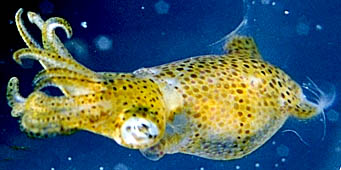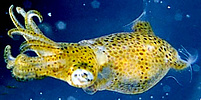Pickfordiateuthis
Grass squid
Michael Vecchione


This tree diagram shows the relationships between several groups of organisms.
The root of the current tree connects the organisms featured in this tree to their containing group and the rest of the Tree of Life. The basal branching point in the tree represents the ancestor of the other groups in the tree. This ancestor diversified over time into several descendent subgroups, which are represented as internal nodes and terminal taxa to the right.

You can click on the root to travel down the Tree of Life all the way to the root of all Life, and you can click on the names of descendent subgroups to travel up the Tree of Life all the way to individual species.
For more information on ToL tree formatting, please see Interpreting the Tree or Classification. To learn more about phylogenetic trees, please visit our Phylogenetic Biology pages.
close boxIntroduction
These are small (22 mm ML max.), muscular squids that occupy neritic waters often in association with small patch reefs and seagrass (Voss, 1953). In spite of the accessible habitat, the squid is rarely captured and little is known of its biology.
Diagnosis
A loliginid ...
- of small size and with posterior fin lobes; fins not joined posteriorly.
- with club suckers on manus in two series.
Characteristics
- Arms
- Suckers in two series.
- Suckers in two series.
- Tentacles
- Club suckers on manus in two series; suckers on dactylus in four series or in two series.
 image info
image info Figure. Oral view of the tentacular club of P. pulchella, 22 mm ML, female, holotype, off Florida Keys. Drawing from Voss (1953).
- Club suckers on manus in two series; suckers on dactylus in four series or in two series.
- Head
- Buccal supports without suckers.
- Buccal supports without suckers.
- Fins
- Fins subterminal.
- Fins oval with free anterior and posterior lobes.
Figure. Left - Ventral view of the posterior mantle and fins of P. pulchella, 22 mm ML, holotype, preserved. Photograph by R. Young. Right - Dorsal view of the same specimen. Drawing modified from Voss (1953).
- Photophores
- Absent.
Comments
The general shape varies greatly between species. P. pulchella is broad with relatively large arms and fins; P. bayeri and P. vossi are slender with small arms and fins. The latter two look look much like a young Doryteuthis.
Brakoniecki (1996) submerged the family Pickfordiateuthidae into the Loliginidae.
Figure. Dorsal view of P. bayeri in a shipboard aquarium.
References
Brakoniecki, T. F. 1996. A revision of the genus Pickfordiateuthis Voss, 1953 (Cephalopoda; Myopsida). Bull. Mar. Sci. 58: 9-28.
Roper, C.F.E. and M. Vecchione. 2001. Pickfordiateuthis bayeri n. sp., a new species of squid (Cephalopoda: Loliginidae) from the western North Atlantic Ocean discovered by submersible. Bull. Biol. Soc. Wash. 10:301-310.
Voss, G. L. 1953. A new family, genus and species of myopsid squid from the Florida keys. Bull. Mar. Sci. Gulf Carib. 2: 602-609.
About This Page
National Marine Fisheries Service
Systematics Laboratory
National Museum of Natural History
Washington, D. C. 20560
USA
Page copyright © 1996
Citing this page:
Vecchione, Michael. 1996. Pickfordiateuthis . Grass squid. Version 01 January 1996 (under construction). http://tolweb.org/Pickfordiateuthis/19861/1996.01.01 in The Tree of Life Web Project, http://tolweb.org/










